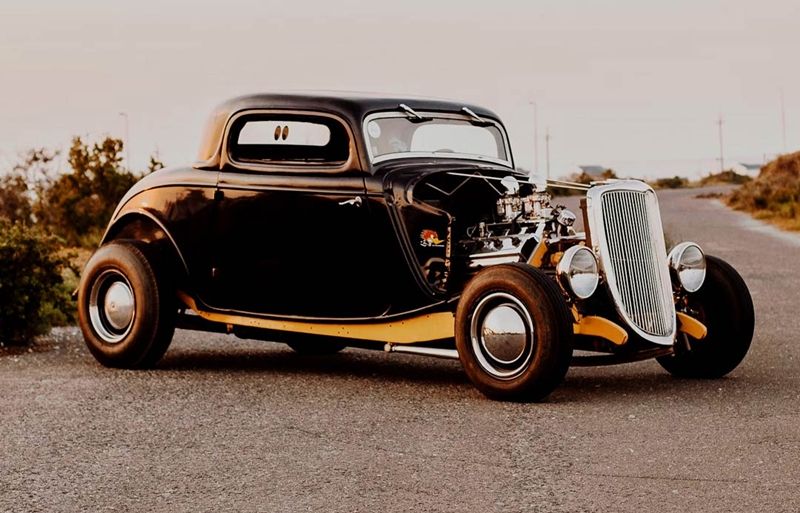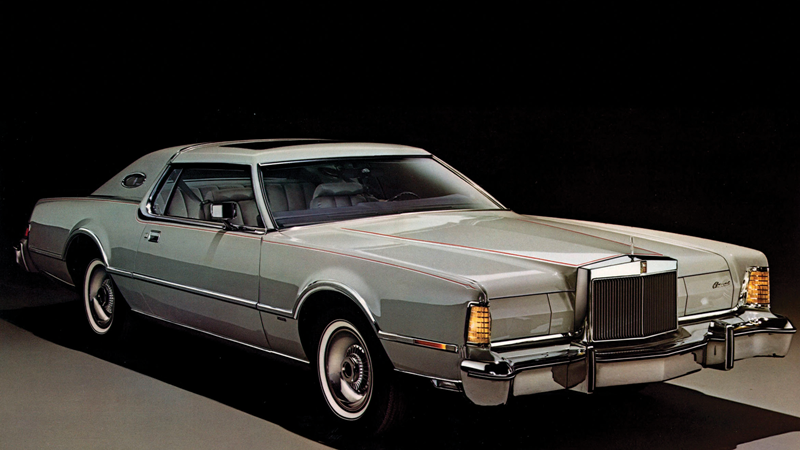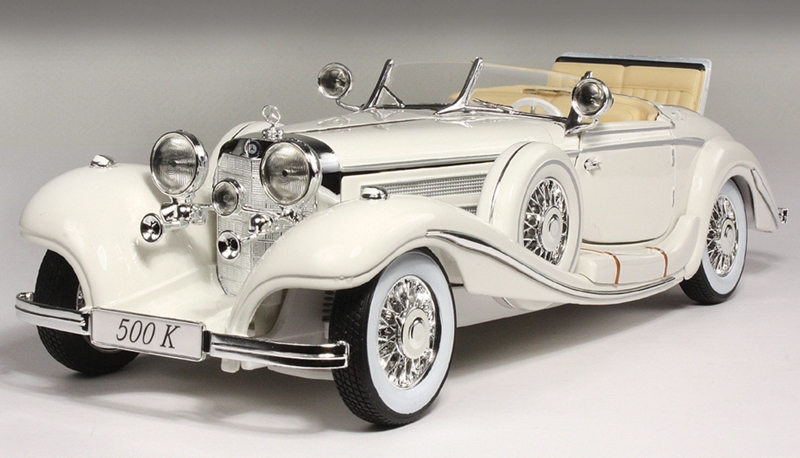Ever wondered how a bunch of teenagers with wrenches and dreams changed the entire automotive landscape forever? Well, buckle up because we’re about to reveal the most shocking secrets of hot rod history that will completely change how you see America’s greatest automotive revolution!
Also read: 10 Shocking Truths About Malaise Era Cars
You know what’s crazy? Most people think they know the story of hot rod history, but the real truth is far more fascinating than Hollywood ever portrayed. These aren’t just cars – they’re the foundation of everything we love about automotive performance today.
Table of Contents
7 Hot Rod History Secrets
Secret #1: Bootleggers Were the Real Hot Rod Pioneers
Here’s a mind-blowing fact about the history of hot rods that most people never learn: It wasn’t rebellious teenagers who started the movement – it was bootleggers during Prohibition!
Picture this: It’s 1925, and alcohol is illegal across America. Bootleggers needed cars that could outrun federal agents, and they weren’t messing around. These guys were stripping down Ford Model Ts and As, removing fenders and hoods to reduce weight, and souping up engines like their lives depended on it – because they literally did!

The earliest hot rodders were actually called “gow jobs” or “soup jobs” back then. Can you believe the term “hot rod” wasn’t even used until the 1940s? These bootlegger pioneers of history of hot rod figured out that removing “unnecessary” parts made their cars lighter and faster. It was pure genius born from necessity.
But wait, there’s more! These bootleggers weren’t just randomly throwing parts together. They were innovators who developed many of the performance modification techniques that would define history of hot rod for decades to come. Talk about learning under pressure!
Secret #2: WWII Surplus Stores Were Hot Rodders’ Secret Goldmines
Now here’s where hot rod history gets absolutely wild! World War II didn’t slow down hot rodding – it supercharged it in ways nobody saw coming.
Thousands of young Americans came back from the war with mechanical skills they’d learned working on aircraft engines, tanks, and other military equipment. But here’s the secret part that will blow your mind: they had access to actual military surplus parts!
Can you imagine walking into a surplus store in 1946 and finding aircraft superchargers, magnetos, and lightweight aluminum wheels just sitting there waiting to be bought? It was like Christmas morning for gearheads! These weren’t car parts – they were high-performance aircraft components that completely transformed hot rod history.
The post-war economic boom meant people had disposable income again. Suddenly, history of hot rod wasn’t just about making do with what you had – it became about pushing the absolute boundaries of automotive performance using military-grade technology.

The California Dream: Where Hot Rod History Really Began
Why did California become the epicenter of history of hot rod? The answer involves a perfect storm of factors that most people never consider.
Sure, everyone knows about the year-round driving weather, but here’s the secret: California’s unique geography created something that didn’t exist anywhere else in America – natural racetracks! The dry lake beds of Southern California (places like Muroc, El Mirage, and Rosamond) provided massive, flat surfaces perfect for high-speed testing.
Every weekend, hundreds of modified cars would descend on these barren landscapes to see who could go the fastest. It was like Burning Man, but with more horsepower and fewer hippies! This geographical advantage gave California hot rodders opportunities that enthusiasts in other states simply didn’t have.
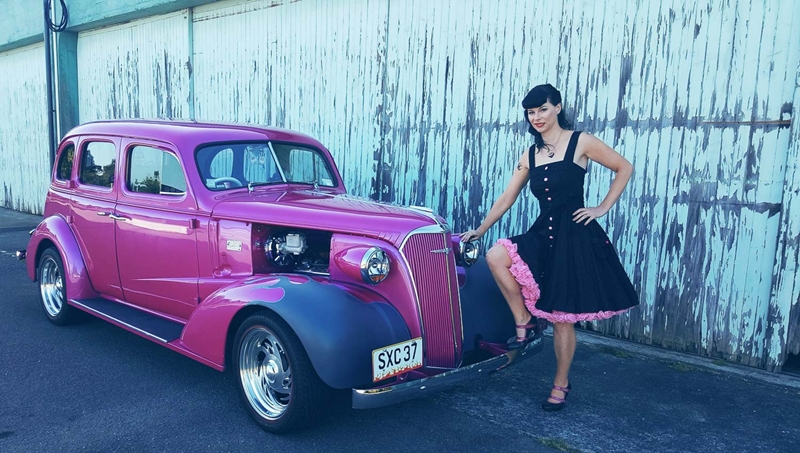
Secret #3: Women Were Hidden Heroes of Hot Rod History
Hollywood has done us no favors here! The movies always show history of hot rod as an all-male world of leather jackets and switchblades, but that’s complete nonsense.
Women were drivers, builders, and influential figures throughout hot rod history from the very beginning. They weren’t just passengers or trophy holders – they were active participants who understood engines, could handle a wrench, and weren’t afraid to get their hands dirty.
Some of the most innovative modifications in the history of hot rod came from women who approached engineering problems differently than their male counterparts. But because of societal attitudes of the time, their contributions were often overlooked or credited to men. It’s one of the most unfair secrets of the history of hot rod.
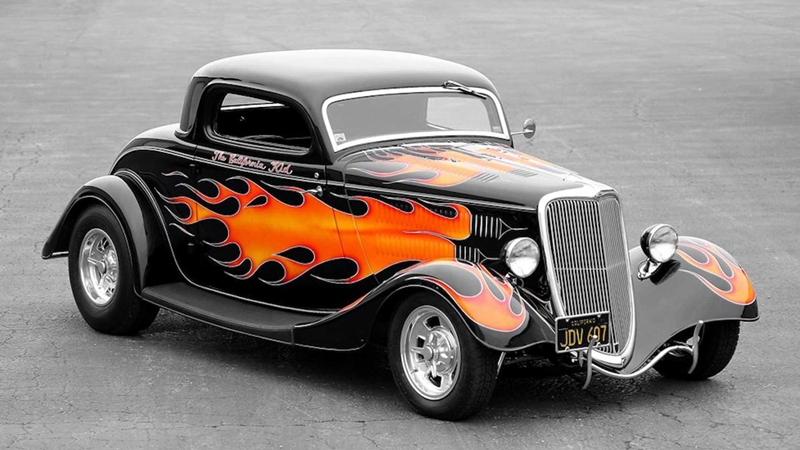
Secret #4: Hot Rodders Were Actually Engineering Geniuses
Here’s a secret that completely destroys the “dangerous rebel” stereotype: Most hot rodders were incredibly careful, methodical engineers who knew exactly what they were doing!
Sure, Hollywood loved to portray them as reckless troublemakers, but the reality of hot rod history was much more sophisticated. Many hot rodders were skilled craftsmen, actual engineers, or mechanics who were pushing automotive technology forward with scientific precision.
The technical innovations that emerged from the history of hot rod literally shaped modern automotive performance. These guys pioneered lightweight construction techniques, improved aerodynamics (even if they didn’t call it that), and developed suspension modifications that would influence racing for decades.
They weren’t throwing parts together randomly – they were conducting careful experiments in performance optimization!
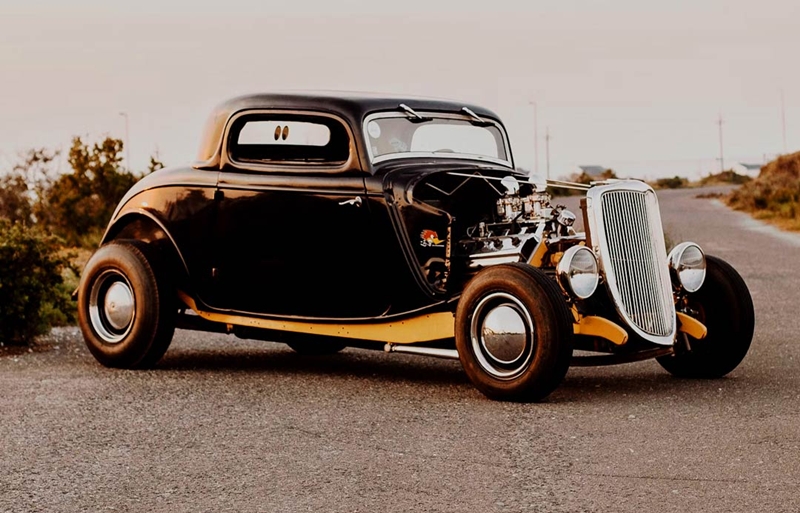
The Golden Age: When Hot Rod History Went Mainstream
The 1950s represent the absolute pinnacle of the classic history of hot rod, but here’s what most people don’t realize: this is when hot rodding transformed from underground subculture to mainstream phenomenon.
Magazine stands started carrying publications like “Hot Rod Magazine” (founded in 1948), and suddenly everyone wanted to learn about these stripped-down speed machines. The organized hot rod clubs that emerged during this period brought structure and community to what had been a scattered movement.
Groups like the Roadsters Club and the Early Times Car Club weren’t just social organizations – they were advancing the technical aspects of hot rod history through organized testing, shared knowledge, and safety campaigns. Who knew rebels could be so organized?
Secret #5: The Real Technical Revolution Behind Hot Rod History
Let’s get into the nitty-gritty of what actually made these cars special, because the technical innovations in hot rod history are absolutely mind-blowing when you understand them.
Engine modifications were the heart of it all. Hot rodders discovered that by increasing compression ratios, advancing timing, and improving airflow, they could extract dramatically more power from existing engines. The famous “flathead” Ford V8, introduced in 1932, became the foundation for countless builds.
But here’s the secret most people miss: it wasn’t just about raw power. Hot rodders were pioneering technologies that wouldn’t appear in production cars for decades! They were the first to understand aerodynamics, weight distribution, and power-to-weight ratios in ways that would make modern engineers proud.

Secret #6: Regional Styles Created Hidden Hot Rod History Variations
Hot rod history wasn’t uniform across America – different regions developed completely unique styles that most people never learn about!
California gave us the classic roadster look, while the East Coast developed its own interpretation with different engine preferences and styling cues. The Midwest became known for practical, no-nonsense builds that prioritized function over form.
Southern hot rodders often incorporated local racing traditions, creating cars that reflected their regional motorsports heritage. These regional differences are still visible today – it’s like automotive archaeology where you can trace influences and see how geography shaped hot rod history.
Download: Regional Styles Comparison Chart
Download the “Regional Styles Comparison Chart” to continue exploring America’s greatest automotive revolution!
Secret #7: Hot Rod History Secretly Shaped Every Modern Performance Car
Here’s the most amazing secret of all: Nearly every performance feature in today’s cars can be traced back to innovations from hot rod history!
Lightweight construction? Hot rodders pioneered it. Aftermarket modifications? They created the entire industry. Performance tuning? They wrote the book. Even modern muscle cars and sports cars owe their existence to lessons learned from decades of hot rod history.
The 1960s muscle car era was essentially Detroit’s attempt to capture hot rod performance in mass-produced packages. Cars like the GTO, Mustang, and Camaro were direct descendants of hot rod history innovations.
Download The 7 Hot Rod History Secrets Detailed Guide
Secret #8: The Underground Racing Networks That Changed Everything
Here’s perhaps the most intriguing secret of hot rod history that reads like something out of a spy novel: Hot rodders created sophisticated underground racing networks with coded communications, secret meeting locations, and elaborate systems to outsmart law enforcement!
Think this sounds far-fetched? Think again! By the 1950s and 1960s, street racing had become so popular that hot rodders developed incredibly sophisticated networks that would make modern flash mob organizers jealous.
The Secret Communication Systems
Hot rodders developed their own coded language system that law enforcement couldn’t crack. They used CB radios (before they became mainstream), specific hand signals, and even coded messages in local newspapers to communicate race locations and times.
Here’s how it worked: A leader would broadcast “The fishing is good at the old pier tonight at midnight” – which actually meant racing would happen at a specific stretch of highway at that time. Can you believe they were this organized?
The Lookout Networks
The most mind-blowing part of hot rod history? These underground networks had actual lookout systems with scouts positioned miles away from racing locations! They used motorcycle riders as mobile communication units, posting lookouts at key intersections, and even had people monitoring police radio frequencies.
When police were spotted heading toward a racing location, the entire network would receive warnings within minutes. Races would disperse instantly, leaving confused officers arriving at empty roads. It was like a military operation disguised as teenage rebellion!
Secret Meeting Locations
Every major city with hot rod culture had secret meeting spots that only insiders knew about. Drive-in restaurants served as headquarters, specific parking lots became gathering points, and abandoned airfields turned into private racing venues.
These locations weren’t random – they were carefully chosen for multiple escape routes, minimal police patrol patterns, and acoustic properties that wouldn’t alert nearby residents. The level of planning was absolutely incredible!
Modern Legacy of Underground Networks
Today’s car meet culture, flash mob racing, and even social media car groups trace their organizational methods directly back to these hot rod history underground networks. The apps we use to organize car meets? They’re just digital versions of the same communication systems hot rodders perfected decades ago.
Street racing networks still use many of the same principles: coded communications, lookout systems, and carefully chosen locations. The technology has evolved, but the fundamental strategies remain unchanged from hot rod history.
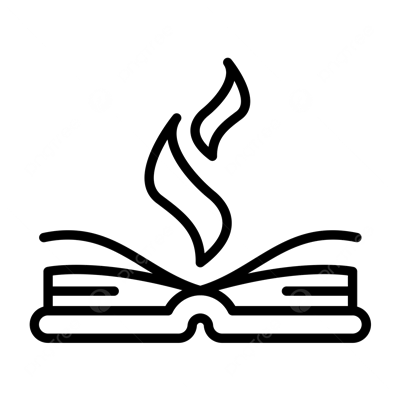
Myths and Legends: What Hollywood Got Wrong About Hot Rod History
Let’s bust some major myths about hot rod history that Hollywood has perpetuated for decades!
Myth #1: All hot rodders were juvenile delinquents
Secret Reality: Most were skilled mechanics, engineers, or simply passionate automotive innovators
Myth #2: Hot rods were always dangerous death traps
Secret Reality: Experienced builders prioritized structural integrity and understood safety principles
Myth #3: Hot rodding was only for the poor
Secret Reality: Building a proper hot rod required significant investment and technical knowledge
Myth #4: Hot rods were just stripped-down junk cars
Secret Reality: The best examples required sophisticated engineering and masterful craftsmanship
Hot Rod History Evolution Through the Decades
The evolution of hot rod history didn’t stop in the 1950s – it kept rolling and adapting to new times, technologies, and generations of enthusiasts.
The 1970s were challenging times for performance cars due to emissions regulations, but hot rodders adapted by developing the pro street movement and beginning the nostalgia trend that defines much of modern hot rod history.
The 1980s and 1990s introduced computer-controlled systems that required hot rodders to learn entirely new skill sets, leading to builders who combined old-school aesthetics with cutting-edge technology.
The Digital Age and Modern Hot Rod History
Today’s hot rod history is being written in pixels as much as pistons. Online forums, YouTube channels, and social media have connected hot rodders globally in ways that would have amazed those 1940s pioneers.
3D printing, CNC machining, and computer-aided design have opened possibilities that early hot rodders never imagined. Yet the fundamental spirit of hot rod history remains identical: creativity, craftsmanship, and the relentless pursuit of speed.
Hot Rod Timeline: Key Milestones in History
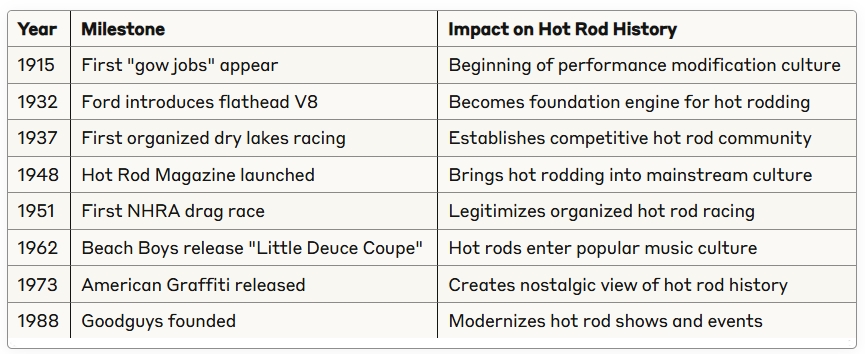
The Dark Side: What Almost Killed Hot Rod History
Here’s the shocking truth nobody talks about: Hot rod history almost ended completely in the late 1960s and early 1970s due to forces that nearly destroyed the entire culture!
The Insurance Industry Attack
Insurance companies launched an all-out war against performance cars and hot rodders. Premiums skyrocketed to impossible levels – we’re talking about insurance costs that exceeded the value of the cars themselves! Young drivers with modified cars were either denied coverage entirely or quoted premiums that made hot rodding financially impossible.
Many insurance companies simply refused to cover any modified vehicle, forcing hot rodders to return their cars to stock condition or face driving without insurance. It was devastating to hot rod history.
Government Regulations Strike
The Clean Air Act of 1970 and subsequent emissions regulations threatened to end hot rod history forever. Suddenly, the high-performance engines that defined hot rod culture were being legislated out of existence. Compression ratios were slashed, horsepower plummeted, and many traditional hot rod modifications became illegal.
The National Highway Traffic Safety Administration also began cracking down on modified vehicles, making it nearly impossible to register cars with significant alterations. Hot rodders faced the real possibility that their lifestyle was becoming criminal.
The Oil Crisis Knockout Punch
The 1973 oil crisis delivered what many thought would be the final blow to hot rod history. Gas prices tripled overnight, and suddenly nobody wanted gas-guzzling performance cars. Hot rod shops closed, magazines folded, and entire communities of builders simply disappeared.
How Hot Rod History Survived
But here’s the incredible part – hot rod history didn’t just survive, it adapted! Hot rodders went underground, developed new techniques for passing emissions tests, and eventually embraced technology that made their cars faster AND cleaner. The culture’s resilience proved that true automotive passion can’t be regulated out of existence.

FAQ: Hot Rod History
-
What’s the difference between a hot rod and a street rod?
In hot rod history, hot rods traditionally refer to pre-1949 cars modified for performance, while street rods focus more on comfort and reliability alongside performance.
-
Q: Why did early hot rodders choose Ford Model A and Model T cars?
These cars were cheap, plentiful, lightweight, and had simple mechanical systems perfect for modification. Plus, aftermarket parts were readily available throughout hot rod history.
-
Were hot rods legal to drive on public streets?
This varied significantly by location and time period in hot rod history. Many early hot rods weren’t street legal due to missing safety equipment.
-
How much did it cost to build a hot rod in the 1950s?
During the golden age of hot rod history, a basic build cost $500-1000 (equivalent to $5,000-10,000 today), while high-end builds could reach $2,000-3,000 or more.
-
Did hot rod culture influence modern automotive design?
Absolutely! The innovations from hot rod history directly influenced modern performance features, styling cues, and entire vehicle categories.
-
What happened to original hot rods from the early days?
Many original examples from early hot rod history were modified repeatedly, crashed, or simply wore out. Unmodified originals are extremely rare and valuable today.

The Legacy Lives On: Final Thoughts
As we conclude this journey through the amazing secrets of hot rod history, one thing becomes crystal clear – this isn’t just a story about cars. It’s a story about American ingenuity, creativity, and the relentless pursuit of automotive perfection.
The influence of hot rod history extends far beyond the automotive world. The DIY ethic, emphasis on individual expression, and constant push for innovation have influenced everything from motorcycle culture to modern tech startups.
Need a mechanic? Find one on the Mobile Mechanic Directory
Today’s hot rodders carry on traditions stretching back over a century, but they’re not living in the past. They’re using modern technology to push boundaries just like their predecessors did, whether building traditional flathead Fords or cutting-edge LS-swapped creations.
Hot rod history teaches us that passion, creativity, and willingness to experiment can lead to incredible innovations. Those early pioneers didn’t just build faster cars – they built the foundation for all modern automotive performance.

